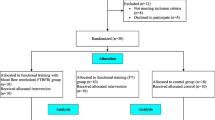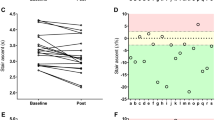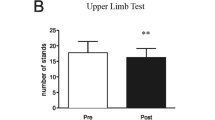Abstract
This study was designed to compare the effects of linear periodization (LP) and undulating periodization (UP) on functional capacity, neuromuscular function, body composition, and cytokines in elderly sedentary women. We also aimed to identify the presence of high responders (HR), medium responders (MR), and low responders (LR) for irisin, interleukin-1 beta (IL-1β), toll-like receptor-4 (TLR-4), and brain-derived neurotrophic factor (BDNF) to resistance training (RT). Forty-nine elderly women were assigned to a control group, LP, and UP scheme. Functional capacity, body composition, maximal strength, irisin, TLR-4, BDNF, and IL-1β were evaluated. Both periodization models were effective in improving 45° leg press 1RM, chair-stand, arm curl, and time-up and go tests, with no significant differences in body composition and cytokines. Furthermore, HR, MR, and LR were identified for irisin, IL-1β, TLR-4, and BDNF, with differences between groups and moments. This study provides evidence that both periodization models were effective in improving functional capacity and neuromuscular function, with no effect on body composition and cytokines (probably as a consequence of the different responsiveness). Furthermore, for the first time, HR, MR, and LR were identified for irisin, IL1-β, TLR-4, and BDNF in response to RT.

Similar content being viewed by others
References
American College of Sports Medicine position stand (2009) Progression models in resistance training for healthy adults. Med Sci Sports Exerc 41(3):687–708
American Thoracic Society (2002) ATS statement: guidelines for the six-minute walk test. Am J Respir Crit Care Med 166(1):111–7
Bostrom P, Wu J, Jedrychowski MP, Korde A, Ye L, Lo JC, Rasbach KA, Boström EA, Choi JH, Long JZ, Kajimura S, Zingaretti MC, Vind BF, Tu H, Cinti S, Højlund K, Gygi SP, Spiegelman BM (2012) A PGC1-alpha-dependent myokine that drives brown-fat-like development of white fat and thermogenesis. Nature 481(7382):463–8
Bouchard C, Blair SN, Church TS, Earnest CP, Hagberg JM, Häkkinen K, Jenkins NT, Karavirta L, Kraus WE, Leon AS, Rao DC, Sarzynski MA, Skinner JS, Slentz CA, Rankinen T (2012) Adverse metabolic response to regular exercise: is it a rare or common occurrence? PLoS One 7(5), e37887
Brown L, Weir J (2001) ASEP procedures recommentation I: Accurate assessment of muscular strength and power. J Exercise Physiol Online 4(3):1–21
Cannon JG, Fielding RA, Fiatarone MA, Orencole SF, Dinarello CA, Evans WJ (1989) Increased interleukin 1 beta in human skeletal muscle after exercise. Am J Physiol 257(2 Pt 2):R451–5
Coelho FG, Gobbi S, Andreatto CA, Corazza DI, Pedroso RV, Santos-Galduroz RF (2013) Physical exercise modulates peripheral levels of brain-derived neurotrophic factor (BDNF): a systematic review of experimental studies in the elderly. Arch Gerontol Geriatr 56(1):10–5
Coelho FM, Pereira DS, Lustosa LP, Silva JP, Dias JM, Dias RC, Queiroz BZ, Teixeira AL, Teixeira MM, Pereira LS (2012) Physical therapy intervention (PTI) increases plasma brain-derived neurotrophic factor (BDNF) levels in non-frail and pre-frail elderly women. Arch Gerontol Geriatr 54(3):415–20
De Lima C, Boullosa DA, Frollini AB, Donatto FF, Leite RD, Gonelli PR, Montebello MI, Prestes J, Cesar MC (2012) Linear and daily undulating resistance training periodizations have differential beneficial effects in young sedentary women. Int J Sports Med 33(9):723–7
Deslandes A, Moraes H, Ferreira C, Veiga H, Silveira H, Mouta R, Pompeu FA, Coutinho ES, Laks J (2009) Exercise and mental health: many reasons to move. Neuropsychobiology 59(4):191–8
Faul F, Erdfelder E, Lang AG, Buchner A (2007) G*Power 3: a flexible statistical power analysis program for the social, behavioral, and biomedical sciences. Behav Res Methods 39(2):175–91
Garcia P, Nascimento DD, Tibana RA, Barboza MM, Willardson JM, Prestes J (2014) Comparison between the multiple-set plus 2 weeks of tri-set and traditional multiple-set method on strength and body composition in trained women: a pilot study. Clin Physiol Funct Imaging. doi:10.1111/cpf.12192: [Epub ahead of print]
Gleeson M, McFarlin B, Flynn M (2006) Exercise and Toll-like receptors. Exerc Immunol Rev 12:34–53
Hecksteden A, kraushaar J, Scharhag-Rosenberger F, Theisen D, Senn S, Meyer (2015) Individual response to exercise training – a statistical perspective. J Appl Physiol. doi:10.1152/japplphysiol.00714.2014
Jones CJ, Rikli RE (2002) Measuring functional fitness of older adults. The Journal on Active Aging 24-30
Kraemer WJ, Adams K, Cafarelli E, Dudley GA, Dooly C, Feigenbaum MS, Fleck SJ, Franklin B, Fry AC, Hoffman JR, Newton RU, Potteiger J, Stone MH, Ratamess NA, Triplett-McBride T (2002a) American College of Sports Medicine position stand. Progression models in resistance training for healthy adults. Med Sci Sports Exerc 34(2):364–80
Kraemer WJ, Ratamess NA, French DN (2002b) Resistance training for health and performance. Curr Sports Med Rep 1(3):165–71
Levinger I, Goodman C, Matthews V, Hare DL, Jerums G, Garnham A, Selig S (2008) BDNF, metabolic risk factors, and resistance training in middle-aged individuals. Med Sci Sports Exerc 40(3):535–41
Loenneke JP, Fahs CA, Abe T, Rossow LM, Ozaki H, Pujol TJ, Bemben MG (2014) Hypertension risk: exercise is medicine* for most but not all. Clin Physiol Funct Imaging 34(1):77–81
Machado M, Willardson JM (2010) Short recovery augments magnitude of muscle damage in high responders. Med Sci Sports Exerc 42(7):1370–4
Mann TN, Lamberts RP, Lambert MI (2014) High responders and low responders: factors associated with individual variation in response to standardized training. Sports Med 44(8):1113–24
Oliveira AG, Carvalho BM, Tobar N, Ropelle ER, Pauli JR, Bagarolli RA, Guadagnini D, Carvalheira JB, Saad MJ (2011) Physical exercise reduces circulating lipopolysaccharide and TLR4 activation and improves insulin signaling in tissues of DIO rats. Diabetes 60(3):784–96
Pardo M, Crujeiras AB, Amil M, Aguera Z, Jiménez-Murcia S, Baños R, Botella C, de la Torre R, Estivill X, Fagundo AB, Fernández-Real JM, Fernández-García JC, Fruhbeck G, Gómez-Ambrosi J, Rodríguez R, Tinahones FJ, Fernández-Aranda F, Casanueva FF (2014) Association of irisin with fat mass, resting energy expenditure, and daily activity in conditions of extreme body mass index. Int J Endocrinol 2014:857270
Prestes J, De Lima C, Frollini AB, Donatto FF, Conte M (2009a) Comparison of linear and reverse linear periodization effects on maximal strength and body composition. J Strength Cond Res 23(1):266–74a
Prestes J, Frollini AB, de Lima C, Donatto FF, Foschini D, de Cássia Marqueti R, Figueira A Jr, Fleck SJ (2009b) Comparison between linear and daily undulating periodized resistance training to increase strength. J Strength Cond Res 23(9):2437–42b
Prestes J, Shiguemoto G, Botero JP, Frollini A, Dias R, Leite R, Pereira G, Magosso R, Baldissera V, Cavaglieri C, Perez S (2009c) Effects of resistance training on resistin, leptin, cytokines, and muscle force in elderly post-menopausal women. J Sports Sci 27(14):1607–15c
Rhea MR (2004) Determining the magnitude of treatment effects in strength training research through the use of the effect size. J Strength Cond Res 18(4):918–20
Rhea MR, Alderman BL (2004) A meta-analysis of periodized versus nonperiodized strength and power training programs. Res Q Exerc Sport 75(4):413–22
Rhea MR, Ball SB, Phillips WT, and Burkett LN (2002) A comparison of linear and daily undulating periodization with equated volume and intensity for strength. J Strength Cond Res 16:250–55.
Shumway-Cook A, Brauer S, Woollacott M (2000) Predicting the probability for falls in community-dwelling older adults using the Timed Up & Go Test. Phys Ther 80(9):896–903
Tajra V, Tibana RA, Vieira DC, de Farias DL, Teixeira TG, Funghetto SS, Silva AO, de Sousa NM, Willardson J, Karnikowski MG, Prestes J (2014) Identification of high responders for interleukin-6 and creatine kinase following acute eccentric resistance exercise in elderly obese women. J Sci Med Sport 17(6):662–6
Westcott WL (2012) Resistance training is medicine: effects of strength training on health. Curr Sports Med Rep 11(4):209–16
Funding
The authors acknowledge the financial support from Conselho Nacional de Pesquisa (483549/2011-8).
Conflict of interest
The authors declare no conflict of interest in the present study.
Author information
Authors and Affiliations
Corresponding author
About this article
Cite this article
Prestes, J., da Cunha Nascimento, D., Tibana, R.A. et al. Understanding the individual responsiveness to resistance training periodization. AGE 37, 55 (2015). https://doi.org/10.1007/s11357-015-9793-x
Received:
Accepted:
Published:
DOI: https://doi.org/10.1007/s11357-015-9793-x




